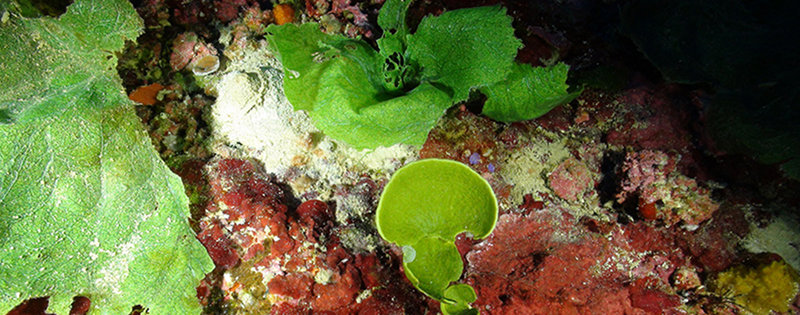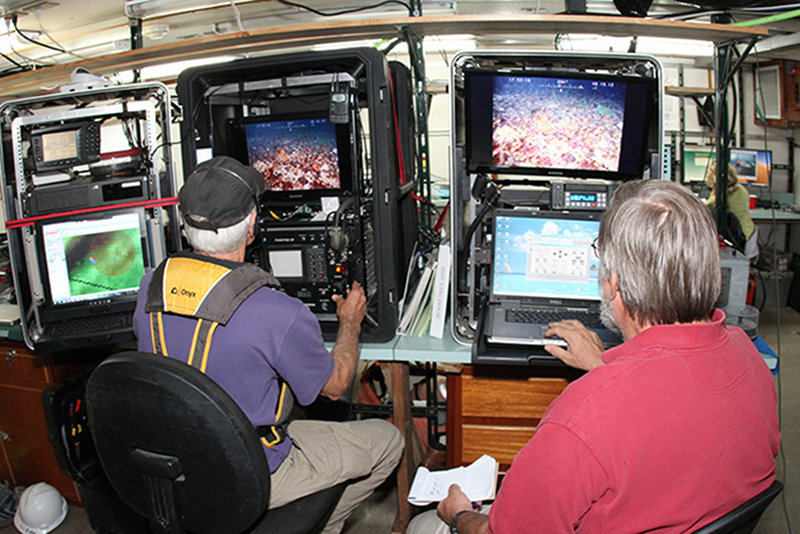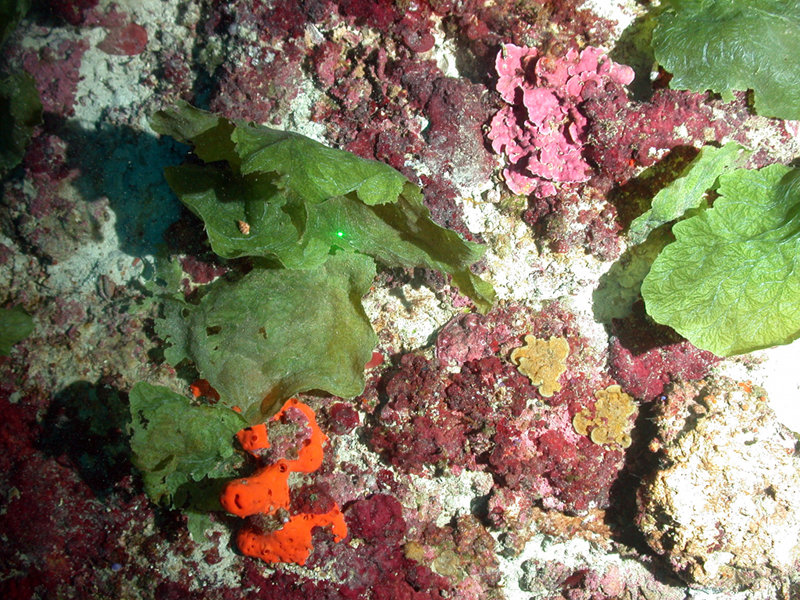
By M. Dennis Hanisak, Chief Scientist for Coral Reef Connectivity 2013 Cruise, and Research Professor - FAU Harbor Branch
August 22, 2013

Halimeda tuna f. platydisca (center) is the only target algal species being collected for the “Population Team” who are using molecular tools to identify relationships among populations throughout the study area. Halimeda is an important producer of carbonate sediments in Florida and Caribbean waters. Image courtesy of M. Dennis Hanisak, FAU Harbor Branch. Download larger version (jpg, 1.6 MB).
I am a phycologist (one who studies algae). Part of my research is on the biology of mesophotic algae. Mesophotic reefs are deeper reef systems (to 150 meters in the clear waters of the subtropics and tropics) that still receive enough light for photosynthesis, the process that drives nearly all ecosystems in the world. I have studied these beautiful and diverse organisms that flourish in the mesophotic zone with research submersibles and ROVs (Remotely Operated Vehicles). I have dove around a good part of Florida, extensively in the Bahamas, a number of islands in the Caribbean, Mexico, Belize, Madeira, the Galapagos archipelago, and the Canary Islands. While there are many differences among these mesophotic algal communities, there are a number of things that these algae have in common.

Chief Scientist Dennis Hanisak (right) sits at the ROV control console with pilot Glenn Taylor, recording video and still images from the remotely operated vehicle at a depth of approximately 80 meters (262 ft). Image courtesy of Brian Cousin, FAU Harbor Branch. Download larger version (jpg, 913 KB).
These little-studied communities are very diverse (large number of species). For example, in extensive surveys with Harbor Branch’s former submersibles, the Johnson-Sea-Link I and II, on Florida’s East Continental Shelf off Palm Beach County, 208 species were identified in the mesophotic algal community down to 100 m, of which 42 were new records for Florida.

The most abundant benthic organisms on Pulley Ridge are algae, especially the green alga Anadyomene menziesii and calcified crustose red algae. Image courtesy of M. Dennis Hanisak, FAU Harbor Branch. Download larger version (jpg, 1.6 MB).
The depth distribution of mesophotic algae is controlled by light. Mesophotic algae are able to live and be productive at extremely low light levels, much lower than what the textbooks say is possible. Near San Salvador Island in the Bahamas, the clarity of the water enables photosynthetic macroalgae to grow deeper than anywhere else on earth (268 meters; 884 feet)!
The deepest algae have morphological and physiological adaptions, which allow them to be more energy efficient in low light. These algae are thin blades or crusts, with all or most of their tissue photosynthetic, unlike thicker species with more non-photosynthetic material that needs to be nourished by photosynthetic cells. Many mesophotic algae have specialized accessory pigments which increase their efficiency of light capture in a low-light environment.
Regardless of how deep macroalgae live in a particular area, the deepest algae are always calcified red algae that form thin crusts on the substrate. They grow very slowly and must have very low respiration rates and the adaptations mentioned above for low-light efficiency.
Which brings me to Pulley Reef … literally. Pulley Ridge is the first place I dove in the mesophotic zone and a phycological oasis in the Gulf of Mexico. The bottom community is overwhelming composed of macroscopic algae. On each of our ROV dives, we observe a most incredible “field of green” … large cabbage-sized plants of Anadyomene menziesii. Closer inspection reveals that most substrate is covered by different species of calcified and other crustose red algae. These algae are ecologically important as they help to build and cement the reef, keeping it intact, providing habitat for fishes and invertebrates, actively stimulating the recruitment of key invertebrates to the reef, and being important primary producers.